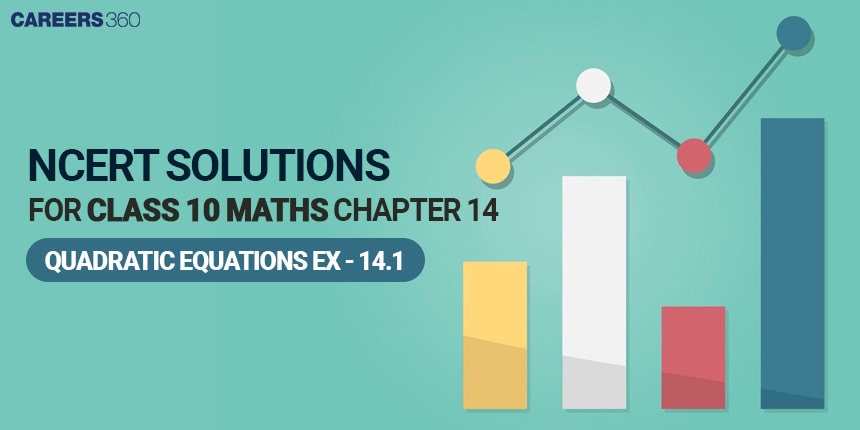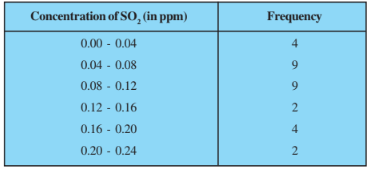Which method did you use for finding the mean, and why?
Answer:
Number of plants | Number of houses | Classmark | |
0-2 | 1 | 1 | 1 |
2-4 | 2 | 3 | 6 |
4-6 | 1 | 5 | 5 |
6-8 | 5 | 7 | 35 |
8-10 | 6 | 9 | 54 |
10-12 | 2 | 11 | 22 |
12-14 | 3 | 13 | 39 |
=20 | =162 |
Mean,
We used the direct method in this as the values of
Q2 Consider the following distribution of daily wages of 50 workers of a factory. Find the mean daily wages of the workers of the factory by using an appropriate method.

Answer:
Let the assumed mean be a = 550
Daily Wages | Number of workers | Classmark | | |
500-520 | 12 | 510 | -40 | -480 |
520-540 | 14 | 530 | -20 | -280 |
540-560 | 8 | 550 | 0 | 0 |
560-580 | 6 | 570 | 20 | 120 |
580-600 | 10 | 590 | 40 | 400 |
= 50 | = -240 |
Mean,
Therefore, the mean daily wages of the workers of the factory is Rs. 545.20

Answer:
Daily pocket allowance | Number of children | Classmark | |
11-13 | 7 | 12 | 84 |
13-15 | 6 | 14 | 84 |
15-17 | 9 | 16 | 144 |
17-19 | 13 | 18 | 234 |
19-21 | f | 20 | 20f |
21-23 | 5 | 22 | 110 |
23-25 | 4 | 24 | 96 |
=44+f | =752+20f |
Mean,
Therefore the missing f = 20
Q4 Thirty women were examined in a hospital by a doctor and the number of heartbeats per minute was recorded and summarised as follows. Find the mean heartbeats per minute for these women, choosing a suitable method.

Answer:
Let the assumed mean be a = 75.5
No. of heartbeats per minute | Number of women | Classmark | | |
65-68 | 2 | 66.5 | -9 | -18 |
68-71 | 4 | 69.5 | -6 | -24 |
71-74 | 3 | 72.5 | -3 | -9 |
74-77 | 8 | 75.5 | 0 | 0 |
77-80 | 7 | 78.5 | 3 | 21 |
80-83 | 4 | 81.5 | 6 | 24 |
83-86 | 2 | 84.5 | 9 | 18 |
=30 | =12 |
Mean,
Therefore, the mean heartbeats per minute of these women are 75.9

Find the mean number of mangoes kept in a packing box. Which method of finding the mean did you choose?
Answer:
Let the assumed mean be a = 57
Number of mangoes | Number of boxes | Classmark | | |
50-52 | 15 | 51 | -6 | -90 |
53-55 | 110 | 54 | -3 | -330 |
56-58 | 135 | 57 | 0 | 0 |
59-61 | 115 | 60 | 3 | 345 |
62-64 | 25 | 63 | 6 | 150 |
=400 | =75 |
Mean,
Therefore, the mean number of mangoes kept in a packing box is approx 57.19
Q6 The table below shows the daily expenditure on the food of 25 households in a locality. Find the mean daily expenditure on food by a suitable method.
Daily expenditure in rupees | 100-150 | 150-200 | 200-250 | 250-300 | 300-350 |
| Number of households | 4 | 5 | 12 | 2 | 2 |
Answer:
Let the assumed mean be a = 225 and h = 50
Daily Expenditure | Number of households | Classmark | | | |
100-150 | 4 | 125 | -100 | -2 | -8 |
150-200 | 5 | 175 | -50 | -1 | -5 |
200-250 | 12 | 225 | 0 | 0 | 0 |
250-300 | 2 | 275 | 50 | 1 | 2 |
300-350 | 2 | 325 | 100 | 2 | 4 |
=25 | = -7 |
Mean,
Therefore, the mean daily expenditure on food is Rs. 211
Find the mean concentration of
Answer:
Class Interval | Frequency | Classmark | |
0.00-0.04 | 4 | 0.02 | 0.08 |
0.04-0.08 | 9 | 0.06 | 0.54 |
0.08-0.12 | 9 | 0.10 | 0.90 |
0.12-0.16 | 2 | 0.14 | 0.28 |
0.16-0.20 | 4 | 0.18 | 0.72 |
0.20-0.24 | 2 | 0.22 | 0.44 |
=30 | =2.96 |
Mean,
Therefore, the mean concentration of

Answer:
Number of days | Number of Students | Classmark | |
0-6 | 11 | 3 | 33 |
6-10 | 10 | 8 | 80 |
10-14 | 7 | 12 | 84 |
14-20 | 4 | 17 | 68 |
20-28 | 4 | 24 | 96 |
28-38 | 3 | 33 | 99 |
38-40 | 1 | 39 | 39 |
=40 | =499 |
Mean,
Therefore, the mean number of days a student was absent is 12.48 days.

Answer:
Let the assumed mean be a = 75 and h = 10
Literacy rates | Number of cities | Classmark | | | |
45-55 | 3 | 50 | -20 | -2 | -6 |
55-65 | 10 | 60 | -10 | -1 | -10 |
65-75 | 11 | 70 | 0 | 0 | 0 |
75-85 | 8 | 80 | 10 | 1 | 8 |
85-95 | 3 | 90 | 20 | 2 | 6 |
= 35 | = -2 |
Mean,
Therefore, the mean mean literacy rate is 69.43%



